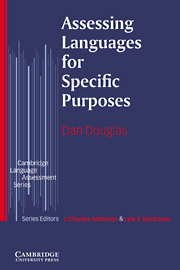Book contents
- Frontmatter
- Contents
- Series editors' preface
- Acknowledgements
- 1 Why test language for specific purposes?
- 2 Specific purpose language ability
- 3 Context, discourse domains, and task characteristics
- 4 Strategic competence: between knowledge and context
- 5 From target language use to test tasks
- 6 Specific purpose tests of listening and speaking
- 7 Specific purpose tests of reading and writing
- 8 LSP test development and technology
- Appendix: other LSP tests
- References
- Index
4 - Strategic competence: between knowledge and context
Published online by Cambridge University Press: 03 May 2010
- Frontmatter
- Contents
- Series editors' preface
- Acknowledgements
- 1 Why test language for specific purposes?
- 2 Specific purpose language ability
- 3 Context, discourse domains, and task characteristics
- 4 Strategic competence: between knowledge and context
- 5 From target language use to test tasks
- 6 Specific purpose tests of listening and speaking
- 7 Specific purpose tests of reading and writing
- 8 LSP test development and technology
- Appendix: other LSP tests
- References
- Index
Summary
Introduction
In this chapter, I want to focus on strategic competence, which mediates between the LSP background knowledge and language knowledge components, on the one hand, and the external features of context which the language user/test taker responds to, on the other. Thus, strategic competence is really the interface between the internal and the external. I will begin by introducing a distinction between two types of strategies within strategic competence, metacognitive strategies and communication strategies. I will then develop a hypothetical example of a test taker's use of these strategies as he or she works through an LSP performance test, finally turning to a discussion of the main points of the theory of specific purpose testing that has been developed so far in the book, pointing the way toward the practice of testing language for specific purposes.
The interface between the external and the internal in specific purpose language use
In this section, I will discuss the processing of specific purpose language in which strategic competence takes a central role: it is important for LSP testers to understand how test takers deal with the information provided for them in the test prompts and input data. Unless testers take care to provide sufficient contextual cues for test takers to attend to, there will be little in the test performance that can be interpreted as evidence of specific purpose language ability. I will begin the discussion, therefore, with a look at the function of strategic competence, followed by a more detailed look at the processes that it comprises.
Information
- Type
- Chapter
- Information
- Assessing Languages for Specific Purposes , pp. 75 - 91Publisher: Cambridge University PressPrint publication year: 1999
